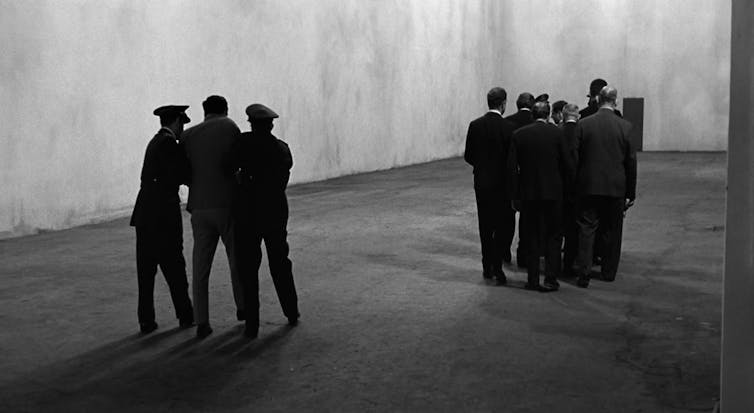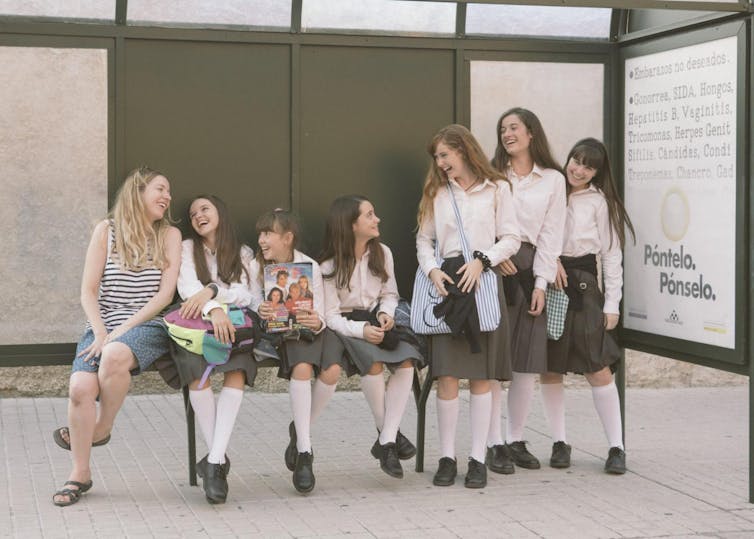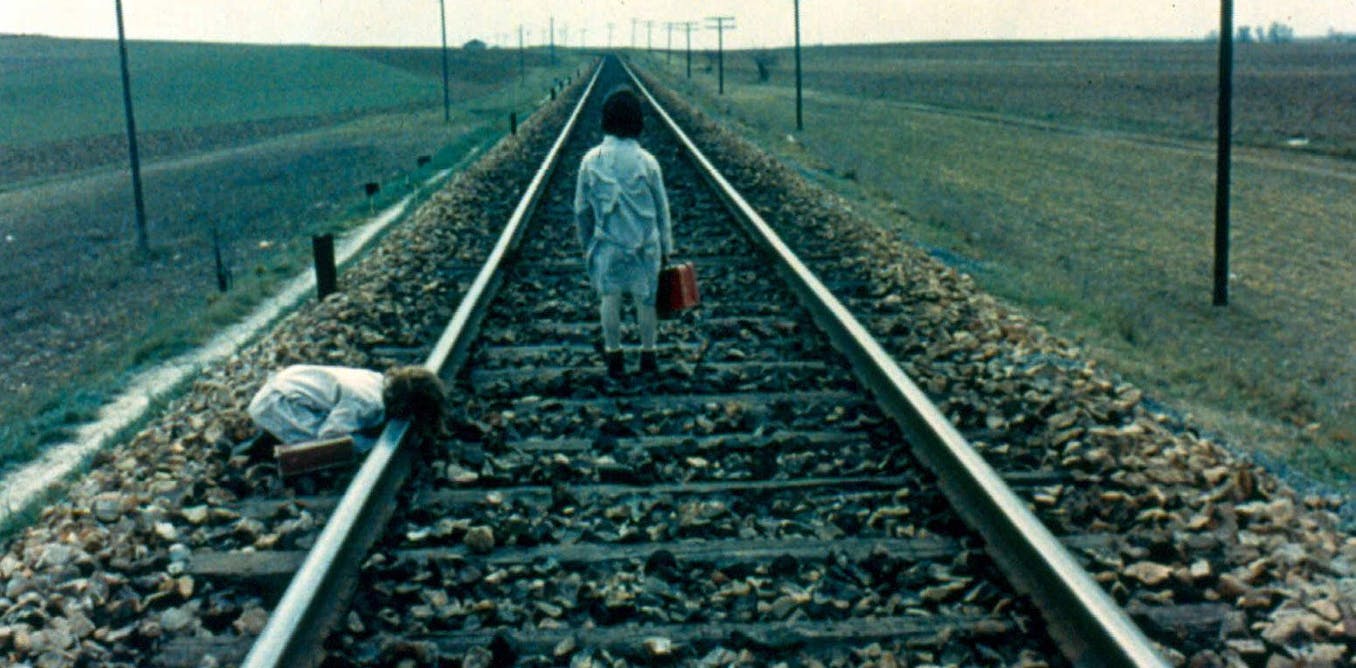[ad_1]
“Who are the Spaniards?” This is the tricky, somewhat perplexing title of a culture module I inherited upon arrival at the University of Limerick. Initially, I turned the question on its head to ask “Who are the Irish?”
I then decided to tackle the topic through films, presenting a potted history of Spain’s history and culture, aiming to pin down its founding myths and tumultuous history, including its dictatorship, transition to democracy and plurinational identities.
Films, like all art and media, are not neutral. Cinema provides one of the most dependable, accessible windows into a national society, as it often depends on government funding or permissions (including censorship), and sidesteps the limitations of illiteracy to reach an extremely broad audience.
1492-1812: Reconquista, empire and the birth of “Spaniards”
Icíar Bollaín’s 2010 metafiction Even the Rain interweaves Christopher Columbus’ arrival in what would become America with the Bolivian Water Wars of 2000. The film straddles multiple time frames: the theft of gold, bodies and souls that began in 1492, in parallel with contemporary multinational corporations and film crews, including underpaid Quechua extras playing Taíno characters, while actively resisting the privatisation of the rain.
Nowadays, imperial revisionists might claim 1492 – which also saw the defeat and annexation of Granada, leading to the expulsion of Spain’s Jews and the end of Islamic rule – to mark birth of the nation under a single identity, if not earlier.
Historians, however, would point to the 18th century War of Succession and the first Bourbon king as Spain’s political starting point, a century after Cervantes’ death. Nonetheless, the common peninsular folk would hardly have identified themselves as “Spaniards” under foreign, inbred rulers like the Austrian Habsburg, or French Bourbon dynasties.
Many people therefore see the Napoleonic invasion and subsequent independence war as marking the dawn of a national identity, along with the 1812 liberal Constitution known as “La Pepa”, where we find the first recorded mention of “Spaniards”. Carlos Saura’s 1999 film Goya in Bordeaux paints a vivid picture of this period, depicting the war as well as the painter’s exile in France after the return of Absolutism.
1814-1936: “two Spains” emerge from a war-torn century
The 19th-century in Spain was marked by numerous wars, in the midst of a lengthy post-imperial depression. As a result, a conception emerges of “two Spains”, which would eventually draw the battle lines in the Spanish Civil War: one half progressive and secular, the other clerical and reactionary. Julio Medem’s 1992 film Cows follows three generations – from the 1870s to 1936 – of rival families in the Basque Country, adhering to this trope of division set among the ancient insularity of the Basque people.
IMDB
The 1920s, Spain’s “Silver Age”, witnessed the friendship of Federico García Lorca, Salvador Dalí and Luís Buñuel, with Dalí and Buñuel joining forces to produce the surrealist, seminal film An Andalusian Dog. Such freedom of expression was soon curtailed, however, by the Spanish Civil War and the ensuing dictatorship.
1939-1975: film, dictatorship and censorship
Censorship was heavy under Franco’s four decade rule, but countless films were still made during the dictatorship. In historical film archives – such as the Criterion Collection – the works of Luis García Berlanga and Víctor Erice feature prominently.
Berlanga’s prolific and often satirical output riffed on Spanish society under the dictatorship, and includes the 1953 sociopolitical comedy Welcome Mr. Marshall! and the 1962 dark comedy Plácido, though Criterion selected The Executioner to represent his work. This jet black comedic masterpiece highlights the incongruencies of late Francoism amidst the tourist boom of the 1960s under the slogan “Spain is different”.
For his part, Erice’s elusive, polyhedral 1973 puzzler The Spirit of the Beehive, casts a mesmerising cinematic spell from the past war to the democracy to come.

IMDB
Spain’s plurinational identities
Butterfly’s Tongue and Black Bread provide parallel insights into Spain’s plurinational identities and languages, which were heavily repressed under the dictatorship.
Both films are coming of age stories that portray the transformation of innocent children into monsters: in Butterfly’s Tongue this changes strikes suddenly, much like the 1936 military coup, while in Black Bread postwar malaise progressively corrodes the young protagonist. Both main characters are byproducts of a violent Francoist society, which not only indoctrinates them, but also encourages and embraces their worst instincts.

FilmAffinity
Butterfly’s Tongue encapsulates the linguistic insecurities of 20th century Galicia – the film was adapted from Galician literature, but shot in Spanish. Black Bread, which was shot in Catalan, presents the post Civil War narrative as a domestic class struggle among Catalan people, rather than against Spanish centralism.
(Re)constructing the fatherland after the dictatorship
Spanish cinema, like much European culture, is somewhat prone to personifying the nation as a woman: in Carlos Saura’s 1990 comedy-drama Ay Carmela!, actor Carmen Maura embodies the Second Republic, with more than a nod to the French republican figure of Marianne.
In the same vein, actor Carolina Bang becomes a patriotic and patriarchal object of desire in Álex de la Iglesia’s chaotic, grotesque 2010 horror-comedy The Last Circus. In a masterstroke of heavy handed symbolism, she is (excuse the spoiler) literally torn in two following a fight between two clowns at the Francoist monument of the Valley of Cuelgamuros – de la Iglesia’s stark, uncompromising metaphor for the gruesome brutality enacted in the name of a divided nation.
Álex de la Iglesia’s oeuvre is defined by spectacular violence: The Last Circus also recreates the 1973 car bomb assassination of Francoist president (and presumed heir to the ageing dictator) Carrero Blanco by the Basque terrorist group ETA.
The 1980s: collective amnesia and the transition to democracy
The once admired transition from dictatorship to democracy is often associated with the 1980s countercultural movement La movida, focused in Madrid but with outposts far across the country (notably in Vigo and Valencia).
The 1980s saw the rise of Pedro Almódovar, who gained international acclaim with films like the cult classic Pepi, Luci, Bom…. However, this hedonistic era of sexual freedom, drugs and punk was partly fuelled by a rush to forget four decades of harsh repression: the 1977 Amnesty Law pardoned all crimes committed during the Civil War and dictatorship, placing equal blame on both sides.
While Almodóvar was long wary of tackling politics, Alberto Rodríguez’ award-winning 2014 rural thriller, Marshland subtly denounces the prevailing silence and injustices of the transition. In this knotty, twisting film, political, economic and judicial elites, as well as torturers, join the new democracy without any accountability for their role in the dictatorship, and without losing the privileges afforded to them by the Francoist regime.

FilmAffinity
1992: a secular awakening
1992 was a landmark year for Spain: it marked the fifth centenary of the so-called “Discovery” of America, the end of the Reconquista, and the expulsion of Jews and Muslims by the Catholic Kings. At the same time, the Barcelona Olympic Games and the Seville World Expo gave it the perfect international platform to present a sophisticated, cosmopolitan face to the world.
Pilar Palomero’s intimate, generational 2020 film Schoolgirls is set in this pivotal year. It centres Spain’s coming of age not on paella, sangría, siesta or bullfighting, but secularisation. It follows a group of girls who grow up in a catholic school while a colourful new society blossoms beyond its drab grey walls.

FilmAffinity
It places these girls caught between the contradictory worlds of religious education and public policy. Between nuns and state sponsored safe sex adverts, they find themselves – like so many Spaniards of the time – searching for their own voices in the back alleys of an austere catholic school.
[ad_2]

Leave a Reply